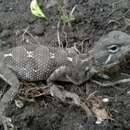fi
nimet breadcrumb-navigoinnissa


Hardwicke's bloodsucker (Calotes minor) is an agamid lizard and found in South Asia.
Physical structure: This is a small stocky and pot-belly lizard with a short tail. Its head large and elongated, flat above, sloping towards snout.[2] Its dorsal scales larger, strongly imbricate and keeled, pointing backward and upward, ventral scales smaller than dorsal; upper head scales larger, unequal, strongly keeled or tubercular.[3] Females are larger than the males.[1]
Color pattern: Dorsal color is olive-brown with three rows of dark-brown light edged spots on the back and base of the tail; spots of middle row are most prominent and rhomboidal; a white streak on each side of the neck is bifurcating behind and an oblique one from the eye to the angle of mouth; limbs are with dark-brown cross bars; throat is profusely spotted with dark-brown and orange; belly is yellowish-white with numerous orange dots.[3] Color inside the mouth is ink-blue.[4] Females are more brilliantly colored during breeding season.[1]
Length: Maximum:18 cm,[2] Common:10 cm. (Snout to vent 6 cm.)[2]
Found in Bangladesh (southeast part of the country), India (Madhya Pradesh, Uttar Pradesh, Rajasthan, Gujarat, Odissa) and Pakistan (Sindh).
Bengali: আগামা গিরিগিটি, পাতি রক্তচোষা, পাতিয়াল গিরিগিটি (Patial girigiti), হার্ডউইকের গিরিগিটি।
English: Hardwicke's bloodsucker, Hardwicke's short-tail agama, dwarf rock agama, and lesser agama.
Hindi & other Indian languages: ?
Urdu & Sindhi: ?
This lizard is terrestrial and sometimes arboreal; inhabits frequently fragmented dry forest, arid environments, barren desert and desolate areas across the Indo-Gangetic plains.[1]
This lizard is diurnal and crepuscular. It shelters in burrows close to the roots of thorny bushes.[1] Generally it is found sitting on stones, but it can climb up shrubby vegetation. It is sluggish in movements, often not attempting to escape when approached.[3] It is a docile species.[5]
This lizard is mainly insectivorous; feeding on grasshoppers and their nymphs, earwigs, beetles, bugs, arthropods and spiders.[3] Sometimes it also eats flowers.[1]
This lizard is oviparous; the breeding season extends from April to June; it lays four to six hard shelled white eggs in burrows under the roots of vegetation.[1]
There are no known practical uses of this species, but it plays a role in the eco-system by eating various types of insects and otherwise.
This lizard is non-venomous and completely harmless to humans.[6]
The species-name minor, a Latin word, meaning 'less' or 'smaller', also referring to the smaller size of this agamid.[7]
This lizard has a reputation for being particularly harmful, which is totally baseless and has contributed much to its depletion.[1]
{{cite journal}}: CS1 maint: multiple names: authors list (link) Hardwicke's bloodsucker (Calotes minor) is an agamid lizard and found in South Asia.